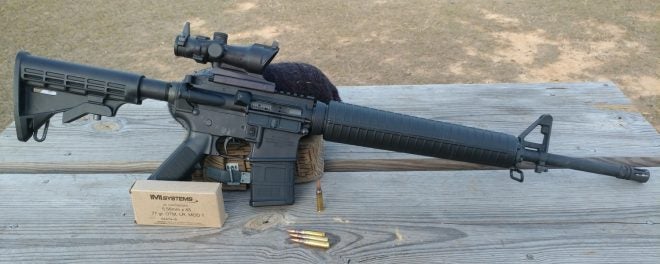The first round up of the Big Freakin’ Cartridge Test is IMI’s take on the Black Hill’s classic heavy precision load, Mk. 262. Branded as “77gr Razor Core”, IMI’s version sports annealed 5.56mm NATO cases, neck and primer sealant, and of course 77gr Open Tip Match projectiles. Continuing on from the first installment, we are now looking at the velocity test results for the 16.1″ and 20″ barrels. The test procedure was as follows:
- Condition ammunition to 70 °F +/- 5 degrees for at least 1 hr (in practice ammunition was always conditioned overnight).
- Mount chronograph to barrel or rail.
- Record the temperature in the conditioned container before each string.
- Withdraw one round of ammunition from the cooler.
- Load and immediately fire the round.
- Cool chamber back to ambient conditions for 30 seconds*
- Repeat steps 3 through 6 nine more times.
This procedure was followed for 14.5″, 16.1″, and 20″ barrel length velocity tests. To measure velocity, a Magnetospeed V3 chronograph was used attached to the barrels of the 16.1″ and 20″ uppers, and the rail of the 14.5″ upper. It needs to be noted that for all 16″ barrel testing, a cooling time of 10 seconds was used instead of 30, as it was becoming obvious that the additional 20 seconds were unnecessary. In the future, 10 seconds will be used for all barrel lengths.
The chronograph results for the 20″ FN chrome-lined CHF barrel are as follows (Shot #, followed by muzzle velocity in ft/s):
1. 2,838
2. 2,836
3. 2,827
4. 2,824
5. 2,824
6. 2,808
7. 2,850
8. 2,818
9. 2,784
10. 2,817
Which gave us the following figures:
Min: 2,784
Max: 2,850
Avg: 2,822
Standard Deviation: 18.0
Extreme Spread (highest minus lowest): 66
And the chronograph results for the 16.1″ Colt chrome-lined cut rifled barrel (Shot #, followed by muzzle velocity in ft/s):
1. 2,746
2. 2,690
3. 2,765
4. 2,733
5. 2,737
6. 2,735
7. 2,730
8. 2,703
9. 2,716
10. 2,748
Which gave:
Min: 2,690
Max: 2,765
Avg: 2,730
SD: 22.1
ES: 75
~2,820 ft/s muzzle velocity for this round is quite solid from the 20″ barrel, although I was a little disappointed with the consistency of the ammunition. Still, the ES and SD for the 20″ and 16.1″ barrels were significantly better than those produced for the 14.5″ barrel, suggesting some sort of issue with my setup for that length. Interestingly, consistency decreased with barrel length, which at least raises the question of whether or not this ammunition performs best from longer barrel lengths in general.
It should also be noted for posterity that the 16.1″ Colt barrel has a history of around 8,000-9,000 rounds down the spout, in contrast with the 14.5″ Criterion barrel which was brand new at the start of the BFCT eval, and the 20″ FN barrel which had a round count in the low hundreds. Before I began this test, I chronographed the Colt barrel in comparison to a new FN 16″ chrome-lined midlength barrel, however, and the two were within 30 ft/s of each other with the same ammunition.
Next up: Golden Tiger’s (Vympel’s) .223 Remington 55gr FMJ.
 Your Privacy Choices
Your Privacy Choices

